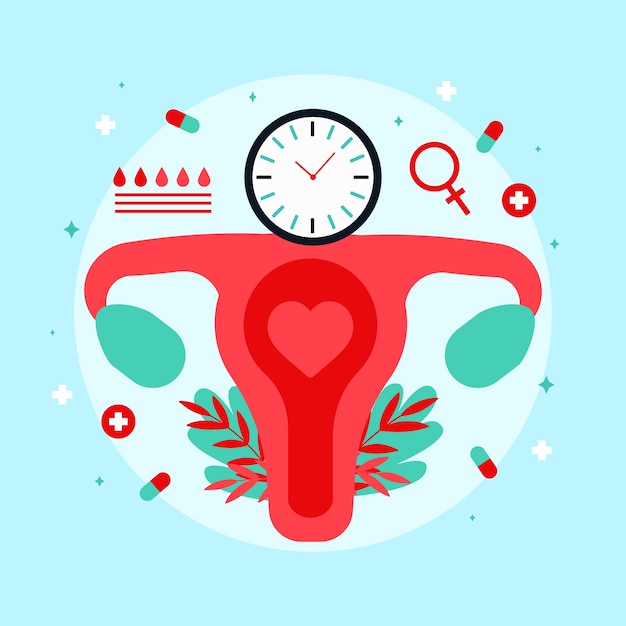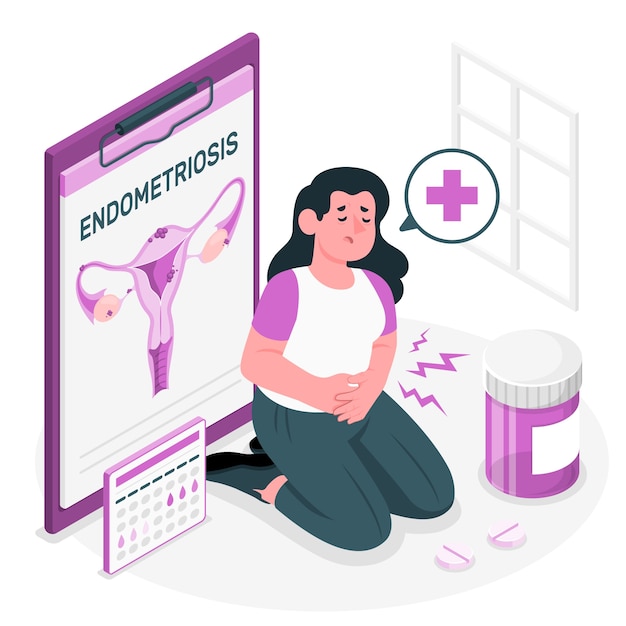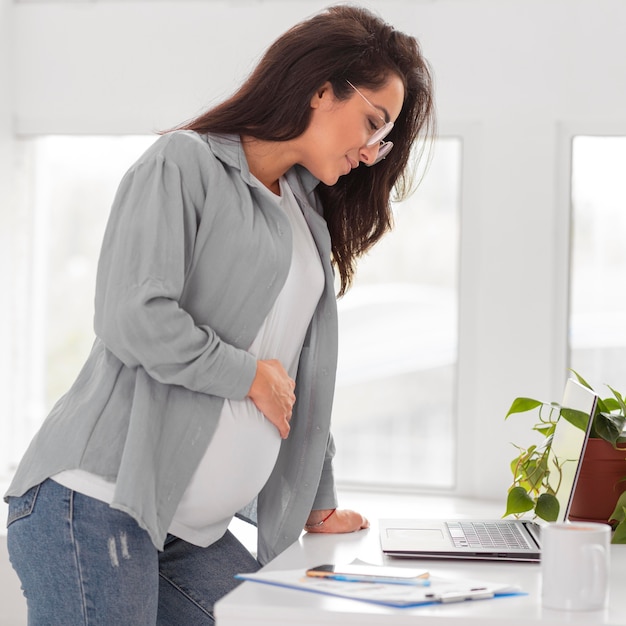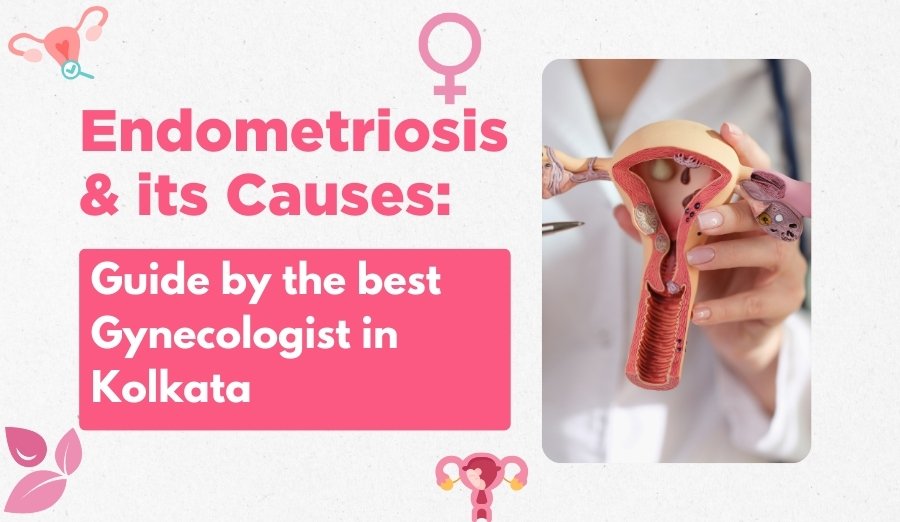What is Endometriosis and What Causes It?
Hello Reader!
Welcome to the blog page of Dr. Megha Khanna, the best gynecologist in Kolkata.
Endometriosis is a complex and often painful condition where tissue similar to the lining inside the uterus (the endometrium) starts to grow outside the uterus. This can affect the ovaries, fallopian tubes, and the tissue lining the pelvis. In rare cases, endometrial-like tissue can be found beyond the pelvic organs. Endometriosis is more common than one might think, affecting an estimated 1 in 10 women of reproductive age worldwide.
As the best gynecologist in Kolkata, I aim to help you manage endometriosis effectively by providing an in-depth understanding of its causes, symptoms, prevention, and treatment options.
Causes of Endometriosis

The exact cause of endometriosis remains unknown, but several factors contribute to its development:
- Retrograde Menstruation: One of the most widely accepted theories is retrograde menstruation. This occurs when menstrual blood flows backward through the fallopian tubes into the pelvic cavity instead of leaving the body, causing endometrial cells to implant and grow outside the uterus.
- Hormonal Imbalance: Estrogen, a hormone responsible for the female reproductive system, is believed to play a key role in promoting endometrial tissue growth outside the uterus.
- Genetics: Women with a family history of endometriosis are at a higher risk of developing the condition. If your mother, sister, or daughter has endometriosis, you are more likely to have it too.
- Immune System Disorders: Problems with the immune system may make the body less capable of recognizing and destroying endometrial-like tissue growing outside the uterus.
- Peritoneal Cell Transformation: Hormones or immune factors promote the transformation of peritoneal cells (the cells lining the inner side of your abdomen) into endometrial-like cells.
- Surgical Scars: After surgeries such as a C-section or hysterectomy, endometrial cells may attach to the surgical incision and start growing there.
- Lymphatic or Blood Spread: Endometrial cells could be transported to other body parts through blood or lymphatic fluid.
Symptoms of Endometriosis

Symptoms of endometriosis vary from person to person, and some women may have mild symptoms, while others experience severe pain. Common symptoms include:
- Pelvic Pain: The most common symptom, which often correlates with the menstrual cycle. However, some women may experience chronic pelvic pain outside their menstrual period.
- Painful Periods (Dysmenorrhea): Intense menstrual cramps that worsen over time.
- Pain During Intercourse: Pain during or after sexual activity is often associated with endometriosis.
- Pain with Bowel Movements or Urination: You may experience pain during bowel movements or while urinating, especially during your menstrual period.
- Excessive Bleeding: You may experience heavy menstrual periods (menorrhagia) or bleeding between periods (menometrorrhagia).
- Infertility: Endometriosis is often first diagnosed in women who are seeking infertility treatment. It can affect fertility by causing adhesions or damage to the ovaries and fallopian tubes.
- Other Symptoms: Fatigue, diarrhea, constipation, bloating, and nausea, especially during menstruation.
If you experience these symptoms, consulting the best gynecologist in Kolkata is crucial for early diagnosis and management.
Prevention of Endometriosis

While there is no guaranteed way to prevent endometriosis, certain lifestyle choices can help reduce your risk:
- Hormonal Contraceptives: Birth control pills, patches, or vaginal rings that contain hormones can help reduce menstrual flow and pain, potentially lowering the risk of developing endometriosis.
- Exercise Regularly: Regular physical activity can help maintain a healthy body weight, reduce estrogen levels, and minimize the risk of endometriosis.
- Avoid Alcohol and Caffeine: Alcohol and caffeine may increase estrogen levels, so limiting their consumption could reduce the risk.
- Maintain a Healthy Diet: A diet rich in fruits, vegetables, whole grains, and low-fat dairy products while avoiding high-fat and processed foods can help maintain hormone balance.
- Early Diagnosis and Treatment: If you suspect any symptoms of endometriosis, consulting with the best gynecologist in Kolkata for early diagnosis and management is vital.
Treatment Options for Endometriosis

Endometriosis treatment focuses on alleviating symptoms and enhancing fertility. The treatment plan depends on the severity of symptoms, the desire for future fertility, and the extent of the disease. Common treatment options include:
- Pain Medications: Nonsteroidal anti-inflammatory drugs (NSAIDs) like ibuprofen can help alleviate mild to moderate pain associated with endometriosis.
- Hormonal Therapies: Hormonal treatments aim to reduce or eliminate menstruation and are effective in slowing endometrial tissue growth. Options include:
- Hormonal Contraceptives: Birth control pills, patches, or vaginal rings help control the hormones responsible for endometrial tissue buildup.
- Gonadotropin-Releasing Hormone (Gn-RH) Agonists and Antagonists: These drugs reduce estrogen levels, leading to reduced or eliminated menstruation.
- Progestin Therapy: Progestin helps reduce endometrial tissue and alleviate symptoms.
- Danazol: A synthetic androgen that reduces estrogen production, but has significant side effects and is less commonly used today.
- Surgical Treatment: Surgery may be recommended in cases of severe endometriosis, especially if you are trying to conceive or have not responded to other treatments. The goal is to remove or destroy endometrial-like tissue without damaging surrounding healthy tissue.
- Laparoscopy: A minimally invasive procedure where endometrial implants are removed or destroyed using a laparoscope.
- Hysterectomy: In severe cases, removing the uterus (hysterectomy) and possibly the ovaries may be necessary, but this is typically considered a last resort.
- Lifestyle and Home Remedies: Regular exercise, heat therapy, acupuncture, and dietary changes can help alleviate symptoms. Stress management techniques such as yoga and meditation can also be beneficial.
Early signs of endometriosis that one should watch for

Here are some of the early signs and symptoms of endometriosis to watch out for:
Painful Periods (Dysmenorrhea)
Severe menstrual cramps that are much worse than normal are one of the most common early signs of endometriosis. The pain may start a few days before your period and last for several days after it ends.
Pelvic Pain
Many women with endometriosis experience chronic pelvic pain, especially during their periods. The pain is often worse right before and after menstruation.
Pain During Intercourse
Painful sex, especially deep pain, is another early indicator of endometriosis. The pain may be felt during penetration or continue after sex.
Painful Bowel Movements or Urination
Endometriosis growths can cause pain with bowel movements or urination, especially during menstrual periods. In rare cases, there may be blood in the stool or urine.
Heavy or Irregular Periods
Endometriosis can cause heavy, long, or irregular menstrual periods. Some women with endometriosis also experience spotting or bleeding between periods.
Infertility
Endometriosis is a leading cause of infertility in women. If you are having trouble getting pregnant, it’s important to discuss endometriosis with your doctor.
Other Symptoms
Additional early signs may include fatigue, diarrhea, constipation, bloating, and nausea, especially during menstrual periods
How can lifestyle changes help manage endometriosis symptoms?
Lifestyle changes can significantly help manage the symptoms of endometriosis, a condition characterized by the growth of endometrial-like tissue outside the uterus, leading to pain and other complications. Here are several key lifestyle modifications that can alleviate symptoms:
Dietary Changes
- Increase Fruits and Vegetables: A diet rich in fresh fruits and vegetables can reduce the risk of developing endometriosis. Studies indicate that women who consume higher amounts of these foods may have a 40% lower risk of the condition compared to those with lower intake levels. This is likely due to the anti-inflammatory properties of these foods, which can help mitigate symptoms.
- Limit Red Meat: High consumption of red meat has been linked to an increased risk of endometriosis. Reducing intake may help lower estrogen levels, which can contribute to the growth of endometrial tissue.
- Incorporate Omega-3 Fatty Acids: Foods rich in omega-3 fatty acids, such as salmon, flaxseeds, and walnuts, have been shown to reduce inflammation and may help alleviate pain associated with endometriosis. Research suggests that individuals with higher omega-3 intake are less likely to develop the condition.
- Avoid Trans Fats and Processed Foods: Diets high in trans fats can increase the risk of endometriosis, while those low in such fats may help reduce symptoms. Opting for healthier fats can support overall hormonal balance.
- Reduce Alcohol and Caffeine: Both alcohol and caffeine may exacerbate endometriosis symptoms. Limiting these substances can potentially improve symptom management.
Physical Activity
- Regular Exercise: Engaging in regular physical activity can help reduce estrogen levels and improve circulation, which may alleviate pain. High-intensity exercises, such as running or cycling, have been associated with a reduced risk of developing endometriosis. Even moderate exercise can release endorphins, which act as natural pain relievers.
- Yoga and Stretching: Low-impact exercises like yoga can help relieve pelvic tension and enhance flexibility, which may reduce pain associated with endometriosis. Incorporating mindfulness and relaxation techniques can also help manage stress levels.
Stress Management
- Mindfulness and Relaxation Techniques: Stress can exacerbate endometriosis symptoms, creating a vicious cycle. Techniques such as meditation, deep breathing exercises, and mindfulness can help reduce stress and improve overall well-being.
- Therapeutic Support: Seeking therapy or counseling can provide emotional support and coping strategies for managing the psychological impact of living with endometriosis. This can be particularly beneficial for those experiencing anxiety or depression related to their condition.
Alternative Therapies
- Acupuncture and Herbal Remedies: Some women find relief from endometriosis symptoms through alternative therapies such as acupuncture or herbal medicine. While research is limited, these approaches may provide additional options for symptom management.
- Consultation with Healthcare Professionals: Working with a healthcare provider, including a dietitian, can help tailor a lifestyle plan that addresses individual needs and preferences, ensuring a holistic approach to managing endometriosis.
Can stress management techniques like meditation help with endometriosis pain?

Stress management techniques, including meditation and mindfulness practices, can indeed help alleviate pain associated with endometriosis. Research has shown that these techniques can improve both physical and emotional well-being for those suffering from this chronic condition.
Benefits of Stress Management Techniques
- Pain Reduction: Mindfulness meditation has been linked to significant reductions in pain levels for individuals with endometriosis. A systematic review indicated that mindfulness practices could enhance pain management and improve quality of life by helping individuals cope with chronic pain more effectively.
- Improved Emotional Well-Being: Living with endometriosis often leads to emotional distress due to chronic pain and its impact on daily life. Mindfulness and meditation promote emotional regulation, helping individuals manage anxiety and depression, which are common in those with endometriosis.
- Enhanced Mind-Body Connection: Practices like yoga not only provide physical benefits but also foster a deeper connection between the mind and body. This connection can help individuals become more aware of their pain and bodily sensations, allowing for better management of symptoms.
- Relaxation and Stress Relief: Techniques such as deep breathing, progressive muscle relaxation, and guided imagery can induce relaxation, reducing muscle tension and stress. This relaxation response can help mitigate the physical symptoms of endometriosis, as stress often exacerbates pain and discomfort.
- Improved Coping Strategies: Regular practice of mindfulness and meditation can equip individuals with better-coping strategies for managing the emotional and psychological stresses associated with endometriosis. This can lead to a more proactive approach to dealing with the challenges posed by the condition.
Specific Techniques to Consider
- Mindfulness Meditation: This involves focusing on the present moment and accepting thoughts and feelings without judgment. It can help reduce the perception of pain and improve overall mental health.
- Yoga: Gentle yoga practices that emphasize mindfulness and controlled movement can help relieve pelvic pain and improve quality of life. Certain poses are specifically beneficial for stretching and relaxing the pelvic area, which can alleviate discomfort.
- Breathing Exercises: Simple breathing techniques can help calm the nervous system and reduce stress. These can be practiced anywhere and are effective for immediate relief during painful episodes.
- Guided Imagery: This technique involves visualizing peaceful images or scenarios to promote relaxation and reduce stress, potentially easing pain sensations.
How often should I practice yoga to see improvements in endometriosis symptoms?

To see improvements in endometriosis symptoms through yoga, research suggests practicing at least twice per week for 8 weeks or more. Here are the key findings:
Frequency and Duration
- A study published in the Journal of Alternative and Complementary Medicine in 2012 found that practicing yoga for 12 weeks led to a significant reduction in pain and menstrual symptoms among women with endometriosis.
- Another study published in the Journal of Obstetrics and Gynaecology Canada in 2017 reported that practicing yoga twice weekly for 8 weeks led to improvements in pain, quality of life, and mental health among women with endometriosis.
- A randomized controlled trial by Gonçalves et al. (2017) found that women with endometriosis who practiced yoga twice per week for 8 weeks had reduced chronic pelvic pain and improved quality of life.
Consistency is Key
While the studies above had participants practice yoga twice weekly, consistency is more important than frequency. Practicing yoga regularly, even if it’s just once or twice a week, is more beneficial than sporadic practice.
Modifying Your Practice
It’s important to listen to your body and modify poses as needed. Avoid vigorous styles like Ashtanga or Vinyasa, which can exacerbate symptoms. Instead, focus on gentle styles like Hatha, Yin, and Restorative yoga that emphasize relaxation and releasing tension in the pelvic area.
Consulting with Professionals
Before starting a yoga practice, it’s best to consult with your gynecologist or a yoga therapist who specializes in women’s health. They can guide poses to focus on and help you develop a practice tailored to your individual needs and symptoms.
FAQ
1. What is Endometriosis?
Endometriosis is a condition where tissue similar to the lining inside the uterus (endometrium) grows outside the uterus, causing pain, inflammation, and sometimes fertility issues. It commonly affects the ovaries, fallopian tubes, and pelvic lining.
2. What Causes Endometriosis?
The exact cause of endometriosis is unknown, but possible factors include retrograde menstruation, hormonal imbalances, genetics, immune system disorders, and surgical scars. These factors may lead to the abnormal growth of endometrial-like tissue outside the uterus.
3. What are the Symptoms of Endometriosis?
Common symptoms include severe pelvic pain, painful periods (dysmenorrhea), pain during intercourse, heavy menstrual bleeding, pain during urination or bowel movements, and infertility. Some women may also experience fatigue, bloating, nausea, or gastrointestinal issues.
4. How Can Endometriosis Be Prevented?
While there is no surefire way to prevent endometriosis, risk can be reduced by maintaining a healthy diet, exercising regularly, managing estrogen levels through hormonal contraceptives, avoiding alcohol and caffeine, and seeking early diagnosis and treatment.
5. What are the Treatment Options for Endometriosis?
Treatment options include pain relief medications, hormonal therapies (like birth control pills and Gn-RH agonists), and surgical options such as laparoscopy to remove or destroy endometrial tissue. Lifestyle changes and alternative therapies, like acupuncture and diet modification, may also help manage symptoms.
Conclusion
Endometriosis is a challenging condition, but understanding its causes, symptoms, and treatment options can help you manage it effectively. If you experience any symptoms or suspect endometriosis, consulting the best gynecologist in Kolkata is crucial for early diagnosis and comprehensive treatment.







